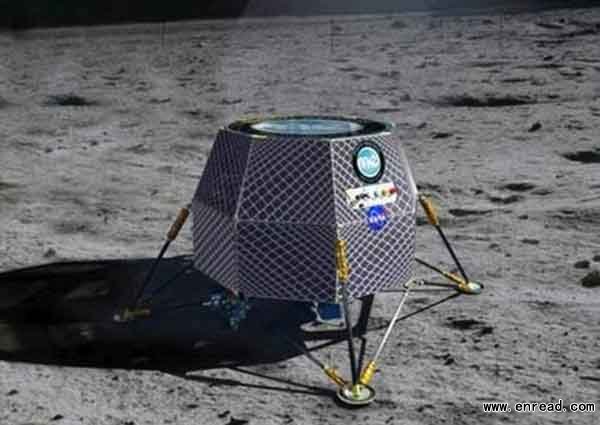| ||||||||||||||||||||||||||||||||||||||||||||||||||||||||||||||||||||||||||||||||||||||||||||||||||||||||
|
Nasa is to try growing vegetables and herbs on the moon to see if humans could one day live there.
美国国家航空航天局决定在2015年去月球上种植蔬菜和草本植物,以此来测试月球是否适合人类生存。
 The seeds will be sent to the moon in the Moon Express Lander (illustrated here by computer generation) in 2015 The US space agency plans to send seeds to the moon in 2015 in sealed canisters(容器) containing everything that is needed for the seedlings1 to thrive.
As well as ten seeds each of basil and turnips2(芜菁), there will also be around 100 seeds of Arabidopsis, a small flowering plant related to cabbage and mustard.
On landing, a trigger will release a small reservoir of water inside the canister and a team on Earth will monitor how the seeds germinate3(发芽,生长) when exposed to lunar gravity and radiation.
A group of scientists, students and volunteers - known as the Lunar Plant Growth Habitat team - are behind the project which will see the seedlings photographed at intervals4 to compare with those planted on earth.
The air in the sealed containers should be adequate for more than 5 days of growth.
A Nasa spokesman said: 'They can test the lunar environment for us, acting5 as a canary in a coal mine.
'If we send plants and they thrive, then humans probably can.'
Thriving plants need the same ingredients for life as humans – food, water and air – and also provide psychological comfort for people, demonstrated by the popular greenhouses in Antarctica and the International Space Station.
Nasa plans on sending the seedlings to the moon by hitching6 a lift on a commercial spacecraft called the Moon Express lander, which is competing to win Google's Lunar X-Prize in 2015.
Scientists are currently constructing a unit to study the germination7 of the plants, which will have a mass of just one kilogram and will be deposited on the moon.
Water will be added to the seeds in the module8 after landing and their growth will be monitored for five to 10 days and compared to Earth-based control seedlings.
Seeds will include Arabidopsis, basil, and turnips and Nasa says the experiment will be the first of its kind on another world and 'an important first step in the utilisation of plants for human life support'.
Follow-up experiments will improve the technology in the growth module and allow for more extensive plant experiments, the organisation9 said.
Survival for 14 days demonstrates plants can sprout10 in the moon's radiation environment but survival to 60 days demonstrates that sexual reproduction (meiosis) can occur in a lunar environment.
点击  收听单词发音 收听单词发音
|
||||||||||||||||||||||||||||||||||||||||||||||||||||||||||||||||||||||||||||||||||||||||||||||||||||||||
上一篇:德国公司研发防蛀牙糖果 下一篇:美国将开展空间站舱外线路修补任务 |
||||||||||||||||||||||||||||||||||||||||||||||||||||||||||||||||||||||||||||||||||||||||||||||||||||||||
- 发表评论
-
- 最新评论 进入详细评论页>>



